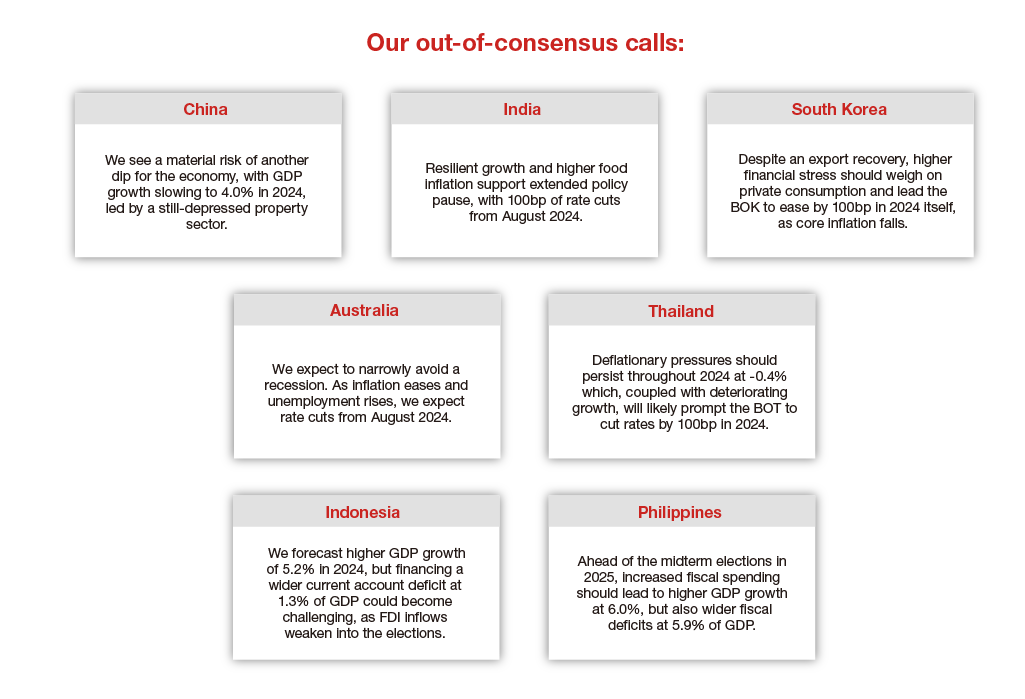Polls for the next US presidential election show that Republican frontrunner Donald Trump is leading incumbent Joe Biden by 2 percentage points nationally. Though polling data are unreliable this far ahead of the November elections, a second term for Trump is a possibility. How would that impact Asia’s economies? Nomura’s analysis breaks it down into the following:
Increased protectionism
Trade protectionism and tariff wars are likely to return. Trump has discussed imposing a universal baseline tariff of 10% on most foreign products imported by the US and threatened to impose penalties on trade partners that engage in currency manipulation or unfair trade practices. This could mean slower export growth for open and export-oriented Asian economies, as US consumers swap out foreign goods for domestic substitutes. The threat of penalties due to currency manipulation could also dissuade Asian central banks from FX intervention and allow their currencies to appreciate.
Trump has reiterated his stance on tighter immigration policies and border control. While his focus has primarily been on Mexico, there is a risk that, similar to his first term, the second term could also include tighter restrictions on H-1B visas, which are used to employ skilled foreign workers. Tighter norms could adversely affect Indians employed in the technology sector as they account for over 70% of the total H-1B visas.
Decoupling from China
There was a significant deterioration of US-China relations during the first Trump presidency through tariffs on Chinese imports, labelling of China as a currency manipulator, and tensions around the Covid-19 pandemic. Some of these have persisted during the Biden administration, but there have been efforts to foster open economic dialogue.
A re-escalation of US-China tensions on trade and investment appears likely under a second Trump presidency. Trump has proposed imposing tariffs of more than 60% on imported goods from China, phasing out imports of essential goods from the country, and enacting restrictions on Chinese ownership of vital US infrastructure and strategic national assets. If enacted, these policies could trigger a tit-for-tat retaliation from China. They would further weigh on China’s exports to the US, which account for about 15% of China’s total goods exports by destination. There may be further trade and investment diversion by the US away from China. China may also look to shift its trade and investment away from the US to more friendly nations, leading to more geoeconomic fragmentation and adding to trade policy uncertainty.
US macro policies
Nomura’s US economics team believes that a potential second term for Trump could mean a slightly more expansionary US fiscal policy. He is likely to make permanent the 2017 individual tax cuts that are set to expire in 2025. However, tax changes would require a unified government, so this is less likely compared with his other policy agenda items. On monetary policy, Trump is likely to push for lower interest rates. He has also recently said that he would not reappoint Federal Reserve Chair Jerome Powell, whose term expires in 2026. Taken as a whole, US macro policies could be marginally more reflationary. For markets, the fiscal-monetary combination could bring US fiscal sustainability concerns to the fore and revive medium-term inflationary concerns. For Asia, US macro policy spillovers could increase volatility.
From green energy to brown
If Trump returns to power, the direction of US industrial policies is likely to shift away from the Biden-era push towards green energy and back towards fossil fuels. According to campaign officials, Trump is likely to roll back regulations such as the Inflation Reduction Act (IRA) aimed at accelerating the transition towards electric vehicles, enact policies to encourage more oil drilling, and speed up the approval of natural gas pipelines into the Marcellus Shale. Biden’s push towards green energy is aligned with the vision of most Asian countries. Asian firms in the EV and battery sectors have invested in the US to take advantage of the IRA. Uncertainty over whether policy support will continue if Trump is re-elected president could prompt firms to put new investment decisions on hold or even roll back previous investments.
America First foreign policy
Trump’s America First approach means a more bilateral rather than a multilateral approach to foreign policy. In Asia, he is likely to maintain a hawkish stance towards China. Countries will be pressed to take sides, increasing polarization risks. His America First approach also means that Asia may rely less on the US as a defender of regional security. While the global geopolitical climate under a Trump presidency is harder to predict, Trump 2.0 could mean more foreign policy uncertainty for Asia.
Macroeconomic implications for Asia
Trump’s first presidential term resulted in significant shocks globally and to Asia. If his bid to win a second term succeeds, there could be less of a shock factor as there’s greater familiarity with his policies. Also, given the ongoing trends of US-China decoupling and shifts in global supply chains, Asia is more prepared this time.
That said, Asia could still be adversely impacted due to lower growth. Geoeconomic fragmentation hurts global trade, a key lifeline for Asia’s open, export-oriented economies.
Within Asia, we expect winners and losers. China could be most adversely impacted due to its position of direct confrontation with the US on multiple fronts. Highly open economies such as Hong Kong, Singapore and South Korea could also be negatively impacted. On the other hand, India and parts of Southeast Asia may benefit from the new growth opportunities created by the reconfiguration and diversification of global value chains.
For more on our growth projections, read our full report.








